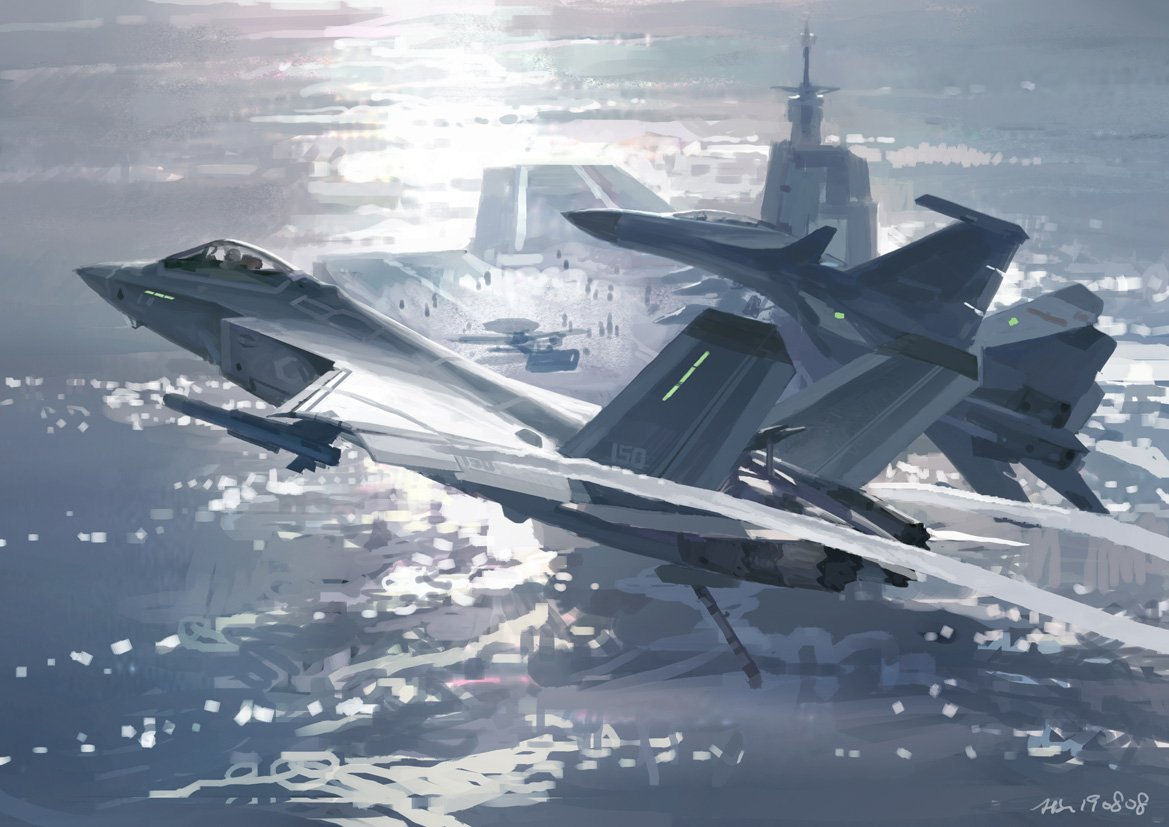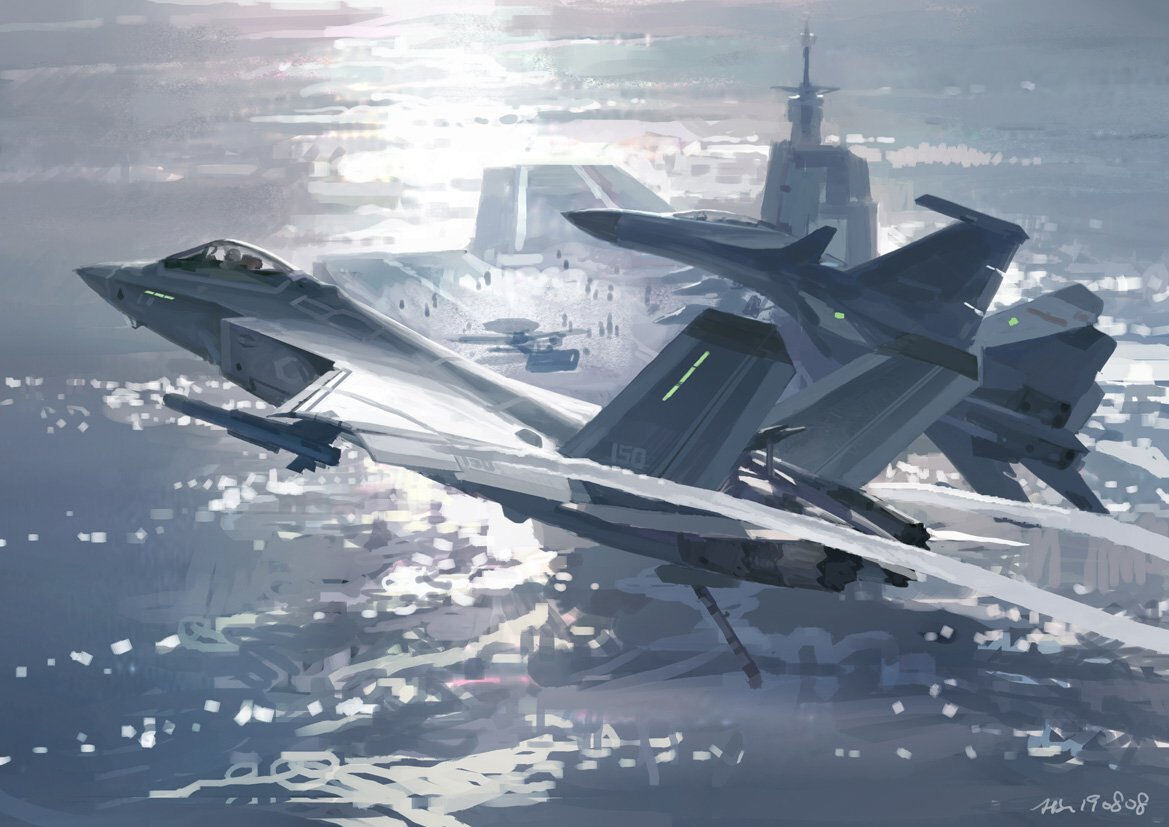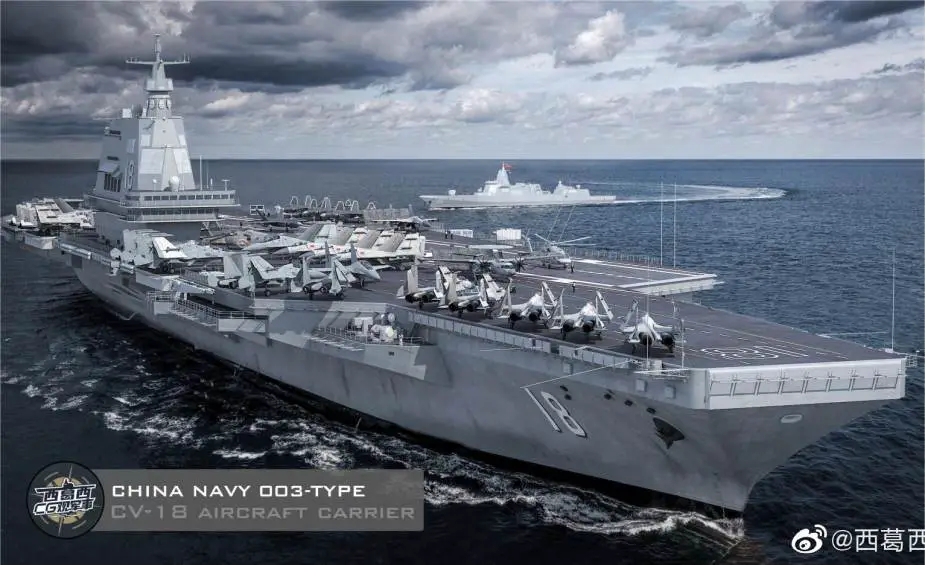 .
.
 .
.
 CNS Fujian (18), the overall third aircraft carrier for the Chinese Navy, had commenced construction some time before 2018, when the first large modules were spotted at builder Jiangnan in Shanghai. The ship was launched from drydock, where most of the assembly took place, in June 2022. Since then fitting out-work had proceeded in a basin to which Fujian had moved after her launch. The supercarrier, displacing over 80,000 tons at a length of approximately 316 metres, is the first catapult-equipped aircraft carrier (CATOBAR) for PLAN, but expected to be followed by multiple future hulls with a similar arrangement over the next decade. Fujian is expected to undergo trials and testing over the next year and may be commissioned with PLAN in 2025.
CNS Fujian (18), the overall third aircraft carrier for the Chinese Navy, had commenced construction some time before 2018, when the first large modules were spotted at builder Jiangnan in Shanghai. The ship was launched from drydock, where most of the assembly took place, in June 2022. Since then fitting out-work had proceeded in a basin to which Fujian had moved after her launch. The supercarrier, displacing over 80,000 tons at a length of approximately 316 metres, is the first catapult-equipped aircraft carrier (CATOBAR) for PLAN, but expected to be followed by multiple future hulls with a similar arrangement over the next decade. Fujian is expected to undergo trials and testing over the next year and may be commissioned with PLAN in 2025.

Chinese Aircraft Carrier Fujian Commences Catapult Testing
First test for electromagnetic catapult system marks an important step in testing phase for the Chinese supercarrier..
The newest Chinese aircraft carrier has started with “dead load” launch testing for her electromagnetic catapult system, as was confirmed by footage circulating on Chinese and Western social media. On November 26 Chinese military-enthusiasts shared footage first on Chinese social media platform Weibo and subsequently also on “X”, formerly Twitter, recorded from an airplane overflying the extensive shipyard facilities where CNS 18 Fujian, also known as the Type 003 aircraft carrier, is currently berthed. Since the Pudong Shanghai International Airport is located very closely to Changxing Island, the location of builder Jiangnan and other shipyards, related imagery taken from passenger planes has become a common source to follow the progress of several major PLAN-programs.

.The video footage shows launch and subsequent drop of a test vehicle from one of the two forward catapult positions on the new aircraft carrier, into the water of the basin in front of Fujian. A large barge used to move hull components had previously relocated from its mooring position also in front of Fujian, ostensibly to make way for this part the testing regime. Similar efforts, termed “dead load”-testing, are common for all catapult-equipped aircraft carriers, including after major overhauls, such as most recently on French Navy-carrier “Charles de Gaulle” in Toulon.
Catapult-testing important step towards sea trial
Overflight and satellite imagery shared on social media on November 19th and over the following days had previously shown Fujian moving away from her berth. The development prompted expectations over a sea trial, although this seemed unlikely at the time, given no preparations to crew and equip the carrier for such a step were visible on the Fujian over the preceding weeks. In fact at least some construction and integration work appears to still be ongoing notably around the island..

.Given the new imagery now the event was likely related to the Chinese aircraft carrier having started catapult testing. This notion is supported also by spotting of several large orange objects likely to represent the dead load-test vehicles. Over the next few days the carrier then returned to her normal berth location. Fujian moving away a short distance and then returning to the mooring position may have been required in the context of testing her starboard third catapult launch position on the angled flight deck, although this remains speculative.
Among enthusiast circles a first sea trial is still expected in the near future, perhaps within a few months, although it is important to consider that Fujian represents a groundbreaking effort with many firsts for builder Jiangnan and operator PLAN. As such timelines may extend considerably beyond optimistic expectations, and past schedules for existing carriers CNS Liaoning (16) and Shandong (17), both lacking catapults, are unlikely to reflect the testing and integration regime for Fujian..
中國海軍首艘003型航空母艦「福建號」CV-18.20231127日傳出完成靜態「電磁彈射」試驗,下一步進行「海試」後就可投入使用,成為全球第二個在航母實裝「電磁彈射」裝置的國家。.
西方社交媒體20231126日流傳一段影音顯示,一個測試飛行器(俗稱:小紅車)從新航母的兩個前彈射器位置之一發射,並隨後落入福建艦前方的水域中。此前一艘大型駁船也從福建艦前方的繫泊位置移走,為這部分測試讓路。
這種電磁彈射測試,稱為「靜載」(dead load)測試,對於所有配備彈射器的航空母艦都很常見。例如最近在土倫的法國海軍航母「戴高樂」號在大修之後也曾進行過彈射測試。美國「海軍新聞」稱台微博上傳一段影音,隨後也在社交媒體X分享一架飛機飛越造船廠設施時拍攝的影音,福建艦 CV-18.
福建艦是中國海軍的第三艘航母,也是第一艘配備電磁彈射裝置的航母,於2018年在上海江南造船廠開工建造。福建艦2022年6月從乾船塢下水。這艘超級航母排水量超過8萬噸,長度約316米,約可搭載40架戰機,每小時航速達30至31浬(約57公里),預計2025年完成海試撥交服役後,可持續完備解放軍在台海周邊的反介入/區域拒止(Anti-Access/Area Denial,簡稱A2/AD)能力,更有能力推遲或阻止美軍進入戰區,協防台灣。美國軍事情報分析認為CV-18.極為可能配給東海艦隊使用.
China’s most advanced “super carrier” Fujian has started testing her electromagnetic catapult system. This makes the Chinese PLA Navy the second only after the US Navy to have the technology. The update also suggests the warship remains on course for its planned deployment in 2025. Fujian is a key piece in China’s People’s Liberation Army (PLA) Navy’s pursuit to challenge the US Navy’s dominance. Fujian is expected to play a key role in “the PLA’s anti-access and area denial strategy” if the US intervenes in a conflict over Taiwan.
.https://youtu.be/4z1L9gnxiuo?si=OtDdUCRrH5OjAN2f
 國際軍事戰略專家分析認為,中國海軍CV-18.福建號航空母艦將於2024.年完成各式各樣的海試測驗項目,並且回饋中國海軍研判該航空母艦的設計參數值與實際海試結果取得的參數值,進行比對交叉試驗,結論進行另外新型航空母艦的設計參考,以利中國海軍升級,建造更新科技化的航空母艦使用,傳聞美國海軍透過特殊管道表示,有興趣參訪中國海軍CV-18.福建號的海試最重要的項目,就是電磁彈射起飛J-35.隱形戰鬥機以及返航時的測試,以比較美國CVN-78.福特號航空母艦與中國航空母艦福建號CV-18.到底誰家的電磁彈射系統優秀..
國際軍事戰略專家分析認為,中國海軍CV-18.福建號航空母艦將於2024.年完成各式各樣的海試測驗項目,並且回饋中國海軍研判該航空母艦的設計參數值與實際海試結果取得的參數值,進行比對交叉試驗,結論進行另外新型航空母艦的設計參考,以利中國海軍升級,建造更新科技化的航空母艦使用,傳聞美國海軍透過特殊管道表示,有興趣參訪中國海軍CV-18.福建號的海試最重要的項目,就是電磁彈射起飛J-35.隱形戰鬥機以及返航時的測試,以比較美國CVN-78.福特號航空母艦與中國航空母艦福建號CV-18.到底誰家的電磁彈射系統優秀..
 .
.

.
How Advanced Is China’s Third Aircraft Carrie ?...
.Aircraft carriers are one of the most visible symbols of a country’s military power. China is among a small handful of countries that possess multiple aircraft carriers. China launched its third aircraft carrier, the Fujian, on June 17, 2022. Once operational, it will be considerably more advanced than China’s second carrier, the Shandong, and its first carrier, the Liaoning.
The Fujian is currently being fitted out at Shanghai’s Jiangnan Shipyard and is expected to undergo multiple rounds of sea trials in the coming months. These trials will ensure its readiness before it is commissioned into the People’s Liberation Army Navy.
Key Facts :The will feature a “catapult assisted take-off but arrested recovery” (CATOBAR) launch system that will enable it to launch heavier and larger fixed-wing aircraft. China’s first two aircraft carriers rely on less advanced ski jump-style “short take-off, barrier-arrested recovery” (STOBAR) systems. Fujian
- The Fujian’s catapults will be powered by an electromagnetic system similar to that of the U.S. Navy’s new Gerald R. Ford-class carriers. This represents a leapfrogging past more conventional steam-powered catapults.
- The is larger than its predecessors, which will enable it to support a more robust airwingIt displaces roughly 80,000 tonnes, compared to the ’s 60,000 tonnes and the ’s 66,000. The is also considerably larger than France’s carrier (42,000 tonnes) and the United Kingdom’s (65,000 tonnes), but smaller than the U.S. Navy’s Ford-class carrier (100,000 tonnes). Fujian. LiaoningShandongFujianCharles de Gaulle HMS Queen Elizabeth
- While the Fujian will be more advanced than its Chinese predecessors, it will still be conventionally powered rather than nuclear-powered. Meanwhile, all U.S. carriers and France’s Charles de Gaulle are nuclear-powered.
Timeline of Key Developments of the Fujian Aircraft Carrier
| Date | Development |
|---|---|
.How the Fujian Stacks Up
The table below provides a breakdown of some of the key characteristics of each of Chinas aircraft carriers. To lean more, explore these ChinaPower pages on the Liaoning and Shandong.
Key Characteristics of Chinas Three Aircraft Carriers
| Liaoning | Shandong | Fujian | |
|---|---|---|---|
.


r. ?...
?...

..

限會員,要發表迴響,請先登入










